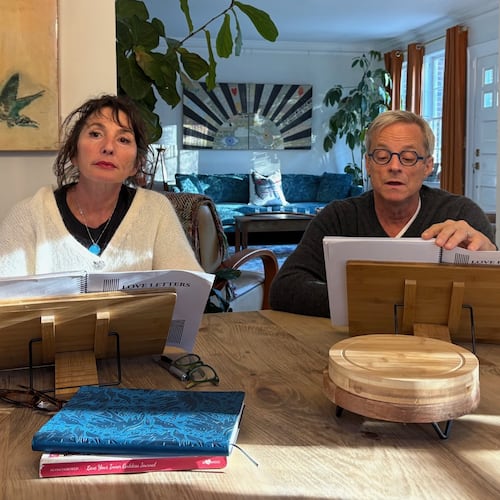In some ways, Canadian photographer David Burdeny and Brit Julia Fullerton-Batten couldn’t be more different.
Burdeny, who has degrees in architecture and interior design, is naturally, enamoured of architecture and land and the stories it can tell of its unseen occupants. He takes photographs of frozen, impressive, real spaces: cityscapes or Utah’s salterns seen from on high or from a privileged point of view.
Credit: Handout
Credit: Handout
His subjects are sublime visions of human achievement: “Paris from the Arc de Triomphe;” grand Italian libraries stuffed with leather books and exquisite woodwork; gondolas bobbing on the silky gray water beside the beautifully crumbling buildings of Venice. In “Mirror Room, Palazzo Ducale, Mantova, Italy” his portrait of a Gothic Venetian palace, the photographer is insistent, pulling us into this undeniably enveloping hallway and the vanishing point of a beckoning doorway. You fall into Burdeny’s spaces, helpless to avoid their allure.
Credit: Handout
Credit: Handout
Burdeny is in a tradition of photographers like Andrew Moore, Massimo Vitali, Andreas Gursky and especially Candida Höfer who offer up humbling, panoramic visions of a world we both recognize and marvel at for its surreality.
Julia Fullerton-Batten, on the other hand, creates marvelous semi-fictions as calculated and meticulously storyboarded as an Alfred Hitchcock thriller. Her delightful “Bathing by Tower Bridge” is like Georges Seurat’s “A Sunday on La Grande Jatte” in its depiction of urban leisure time. The photograph depicts a staged crowded beach in the 1950s by the Thames where a diverse gaggle of Londoners takes the sun, each engrossed in their own private reverie. Fullerton-Batten often roots her images in historical truth, and the reality that in London of the past, King George V did decree that his citizens could sunbathe and frolic on the bank of the Thames on imported sand at low tide.
But Fullerton-Batten created the work on-site and in-studio in the same way a Hollywood film might use a swimming pool to stand in for the ocean. Magical hybrids of technology and imagination, Fullerton-Batten’s scenes are the kind of carefully calibrated moments that would have in previous centuries, been captured by painters, though her surreal lighting effects are indebted to cinema. An exquisite example is the wonderful “Flooding of Tate Britain” based on a real 1928 incident in which a battery of workers, sleeves rolled up, rescue priceless oil paintings from the murky waters lapping through the galleries of that famous London museum. Many of Fullerton-Batten stories feel fantastic, invented, but are based in reality, like her series (not shown at TEW) “Feral Children” about neglected children raised by animals, or left to raise themselves.
But Burdeny and Fullerton-Batten are very much alike in the pregnant, almost sinister stillness of their images. We hang expectantly on the feeling of “what next?” that their images evoke. Both Burdeny and Fullerton-Batten play with the pregnant expectation photography always offers this: our knowledge that only one tiny moment in time has been captured and that there is an entire world unfolding beyond its margins. Both photographers intertwine realism laced with magic. In these travel-strapped times, they allow us to travel to actual places and imagined ones plucked from history.
Credit: Handout
Credit: Handout
Burdeny’s scenes are often devoid of people. We, in fact, are the people in his scenes, with a perfect view arrayed for our greedy eyes. And Fullerton-Batten’s photos are defined by people who we can’t help but activate in our mind’s eye, into players in the complex dramas she has set up that we long to fill in beyond the margins. In an image from her series “Looking Out From Within” meant to capture the isolation of quarantining during COVID-19, Fullerton-Batten photographs an older woman “Kitty” in a chartreuse dress who has lowered the blue surgical mask from her mouth. The photographer’s vantage is from outside as Kitty peers out her apartment window, another human statue caught in her own lonely trance.
EXHIBIT PREVIEW
“David Burdeny - Travels,” “Introducing Julia Fullerton-Batten”
Through Feb. 20. 10 a.m.-5 p.m. Mondays-Fridays, 11 a.m.-5 p.m. Saturdays, Free. Tew Galleries, 425 Peachtree Hills Ave.NE #24, Atlanta. 404-869-0511, tewgalleries.com
Bottom line: Stunning blends of cinematic-style magic and calculation blend in the work of two very different photographers.
About the Author
The Latest
Featured




